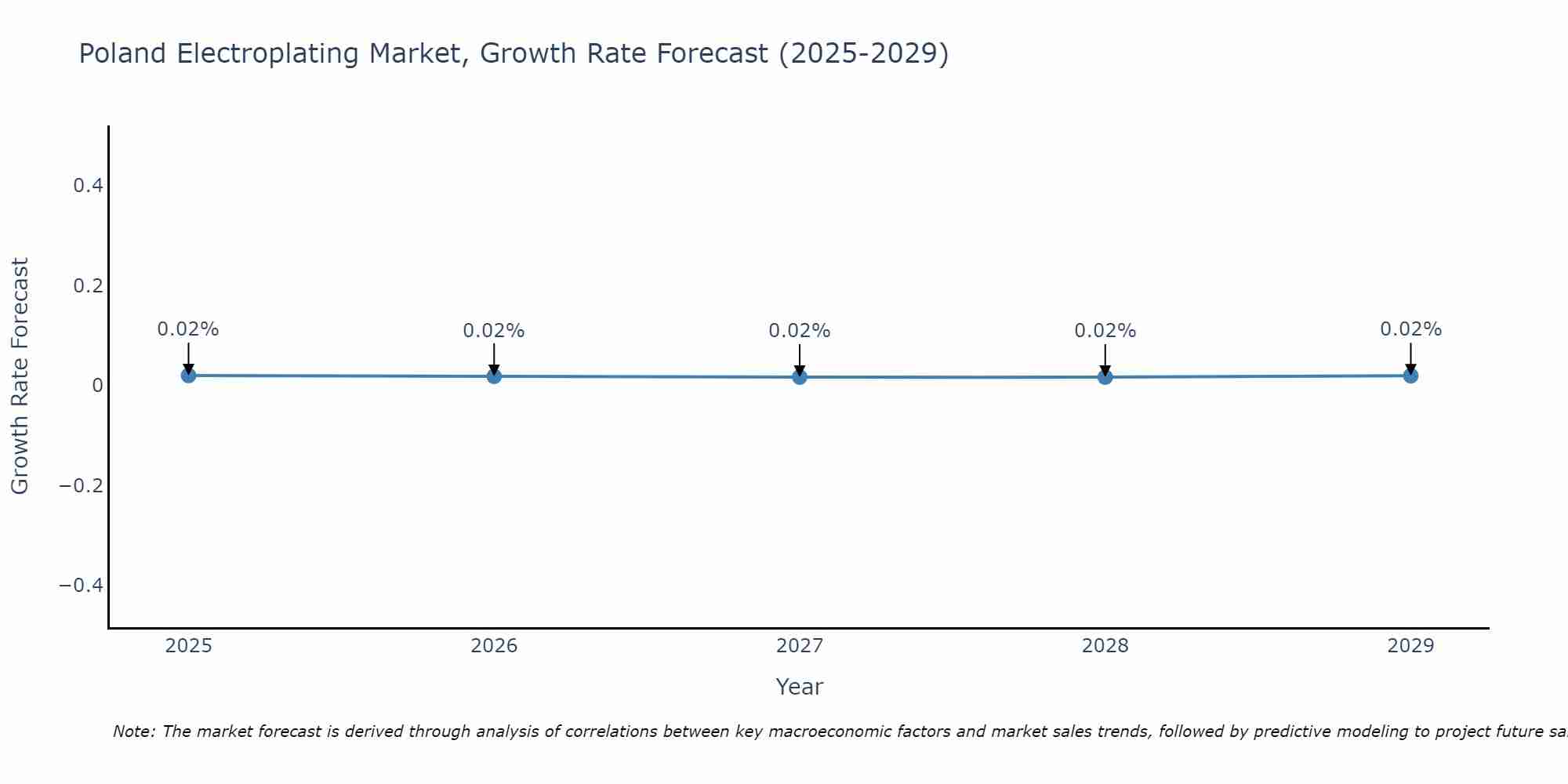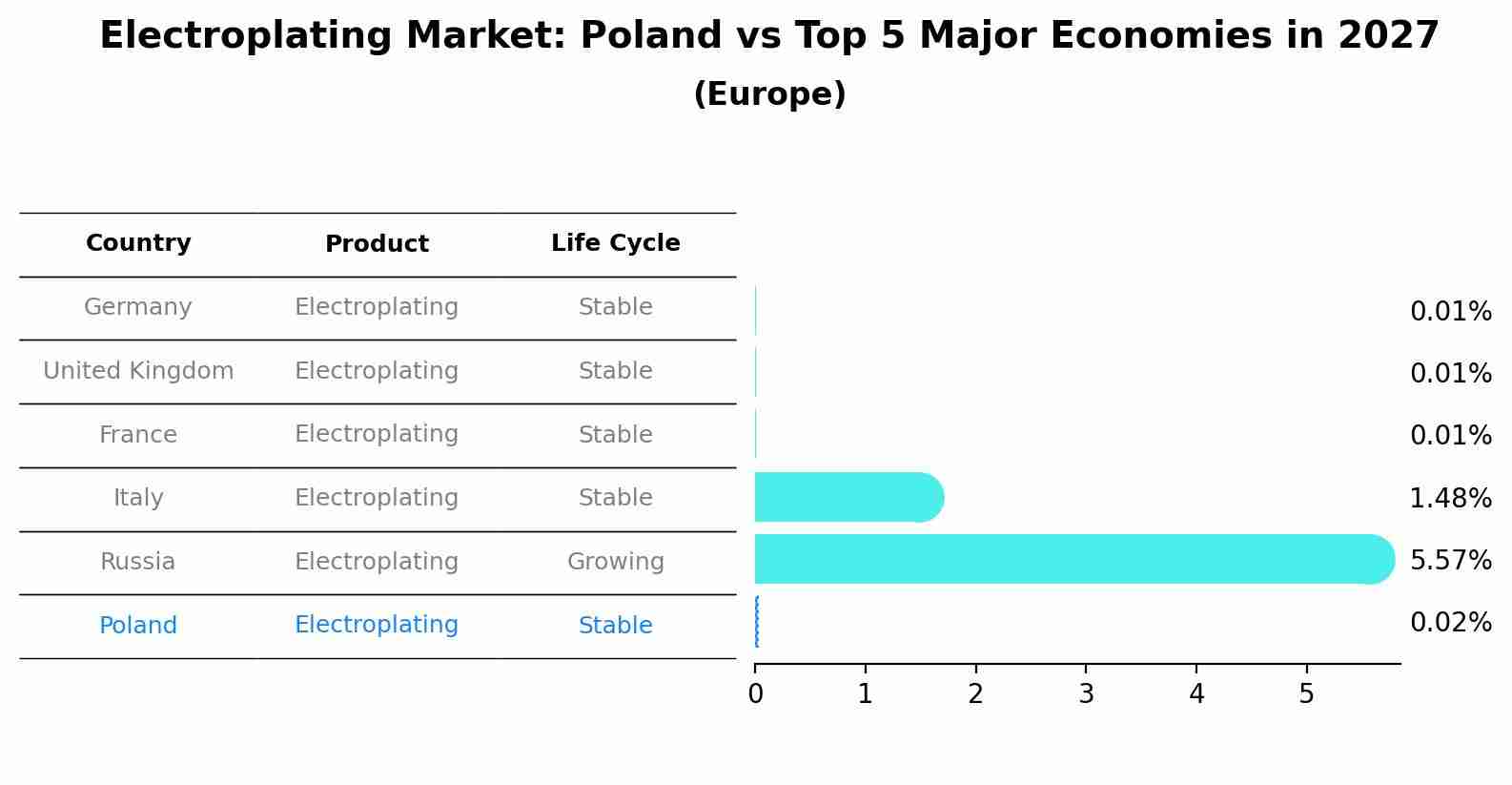Poland Electroplating Market (2025-2031) Outlook | Trends, Forecast, Share, Growth, Industry, Companies, Revenue, Size, Value, Analysis
| Product Code: ETC104614 | Publication Date: Jun 2021 | Updated Date: Jun 2025 | Product Type: Report | |
| Publisher: 6Wresearch | Author: Ravi Bhandari | No. of Pages: 70 | No. of Figures: 35 | No. of Tables: 5 |
Poland Electroplating Market Size Growth Rate
The Poland Electroplating Market is projected to witness mixed growth rate patterns during 2025 to 2029. Beginning strongly at 0.02% in 2025, growth softens to 0.02% in 2029.

Electroplating Market: Poland vs Top 5 Major Economies in 2027 (Europe)
The Electroplating market in Poland is projected to grow at a stable growth rate of 0.02% by 2027, highlighting the country's increasing focus on advanced technologies within the Europe region, where Germany holds the dominant position, followed closely by United Kingdom, France, Italy and Russia, shaping overall regional demand.

Poland Electroplating Market Overview
The Poland Electroplating Market is witnessing steady growth driven by increasing demand from automotive, electronics, and aerospace industries. The market is characterized by the presence of both domestic and international players offering a wide range of services including zinc, nickel, chrome, and gold plating. The automotive sector is a major consumer of electroplating services due to the need for corrosion protection and aesthetic appeal of components. Additionally, stringent environmental regulations are pushing companies to adopt eco-friendly plating technologies such as trivalent chromium plating. The market is competitive, with players focusing on innovation, quality, and sustainability to gain a competitive edge. Overall, the Poland Electroplating Market is expected to continue its growth trajectory fueled by industrial development and technological advancements.
Poland Electroplating Market Trends
The Poland Electroplating Market is experiencing a shift towards environmentally friendly practices, with a growing demand for eco-friendly plating solutions that reduce the use of hazardous chemicals and minimize waste generation. Companies are investing in technologies that offer more sustainable and energy-efficient processes, such as water-based coatings and alternative plating methods like electroless plating. Additionally, there is a rising focus on enhancing the durability and corrosion resistance of products through advanced coating techniques, driven by the automotive and electronics industries. The market is also witnessing an increasing adoption of automation and digitalization to improve efficiency and quality control in electroplating processes. Overall, the Poland Electroplating Market is moving towards a more sustainable and technologically advanced future to meet evolving customer demands and regulatory requirements.
Poland Electroplating Market Challenges
In the Poland Electroplating Market, some of the key challenges include increasing environmental regulations and sustainability concerns related to the use of chemicals and water in the electroplating process. Compliance with stringent regulations adds to the operational costs for companies in the industry, requiring investments in pollution control technologies and sustainable practices. Another challenge is the intensifying competition from low-cost manufacturers in other regions, which puts pressure on pricing and margins for Polish electroplating companies. Additionally, the industry is facing technological advancements and the need for continuous innovation to meet evolving customer demands for high-quality, durable, and environmentally-friendly electroplated products. Overall, navigating these challenges requires a strategic focus on sustainability, compliance, innovation, and cost-efficiency in the Poland Electroplating Market.
Poland Electroplating Market Investment Opportunities
The Poland Electroplating Market offers promising investment opportunities due to the country`s growing industrial sector and increasing demand for electroplated products in various industries such as automotive, electronics, and aerospace. With a focus on environmental sustainability and compliance with regulations, there is a rising need for advanced electroplating technologies and services in Poland. Investors can explore opportunities in providing innovative and eco-friendly electroplating solutions, investing in research and development of new plating materials and techniques, or acquiring existing electroplating businesses to expand their market presence. Additionally, partnerships with local manufacturers and suppliers can help investors capitalize on the market`s potential and establish a strong foothold in the growing electroplating industry in Poland.
Poland Electroplating Market Government Policy
The Polish government has implemented several policies to regulate the electroplating market in the country. These include environmental protection regulations to ensure that electroplating companies adhere to strict standards for waste disposal and pollution control. Additionally, the government has put in place measures to promote sustainable practices within the industry, such as encouraging the use of eco-friendly plating technologies and reducing the use of hazardous chemicals. Furthermore, there are regulations in place to ensure worker safety and health in electroplating facilities. Overall, the government`s policies aim to balance economic growth in the electroplating sector with environmental conservation and worker well-being.
Poland Electroplating Market Future Outlook
The future outlook for the Poland Electroplating Market appears promising, driven by the increasing demand from automotive, electronics, and manufacturing industries. The market is expected to witness steady growth due to the rising adoption of electroplating techniques for enhancing the aesthetic appeal, corrosion resistance, and durability of products. Additionally, stringent environmental regulations are likely to boost the adoption of eco-friendly electroplating processes, such as trivalent chromium plating, further driving market growth. Technological advancements, such as automation and digitization in electroplating processes, are also anticipated to fuel market expansion. Overall, the Poland Electroplating Market is poised for growth in the coming years, supported by industry advancements and evolving consumer preferences towards high-quality, durable products.
Key Highlights of the Report:
- Poland Electroplating Market Outlook
- Market Size of Poland Electroplating Market, 2021
- Forecast of Poland Electroplating Market, 2031
- Historical Data and Forecast of Poland Electroplating Revenues & Volume for the Period 2021 - 2031
- Poland Electroplating Market Trend Evolution
- Poland Electroplating Market Drivers and Challenges
- Poland Electroplating Price Trends
- Poland Electroplating Porter's Five Forces
- Poland Electroplating Industry Life Cycle
- Historical Data and Forecast of Poland Electroplating Market Revenues & Volume By Metal for the Period 2021 - 2031
- Historical Data and Forecast of Poland Electroplating Market Revenues & Volume By Gold for the Period 2021 - 2031
- Historical Data and Forecast of Poland Electroplating Market Revenues & Volume By Copper for the Period 2021 - 2031
- Historical Data and Forecast of Poland Electroplating Market Revenues & Volume By Nickel for the Period 2021 - 2031
- Historical Data and Forecast of Poland Electroplating Market Revenues & Volume By Others for the Period 2021 - 2031
- Historical Data and Forecast of Poland Electroplating Market Revenues & Volume By Type for the Period 2021 - 2031
- Historical Data and Forecast of Poland Electroplating Market Revenues & Volume By Barrel Plating for the Period 2021 - 2031
- Historical Data and Forecast of Poland Electroplating Market Revenues & Volume By Rack Plating for the Period 2021 - 2031
- Historical Data and Forecast of Poland Electroplating Market Revenues & Volume By Continuous Plating for the Period 2021 - 2031
- Historical Data and Forecast of Poland Electroplating Market Revenues & Volume By Line Plating for the Period 2021 - 2031
- Historical Data and Forecast of Poland Electroplating Market Revenues & Volume By End-User Industry for the Period 2021 - 2031
- Historical Data and Forecast of Poland Electroplating Market Revenues & Volume By Automotive for the Period 2021 - 2031
- Historical Data and Forecast of Poland Electroplating Market Revenues & Volume By Electrical and Electronics for the Period 2021 - 2031
- Historical Data and Forecast of Poland Electroplating Market Revenues & Volume By Aerospace and Defense for the Period 2021 - 2031
- Historical Data and Forecast of Poland Electroplating Market Revenues & Volume By Medical for the Period 2021 - 2031
- Historical Data and Forecast of Poland Electroplating Market Revenues & Volume By Others for the Period 2021 - 2031
- Poland Electroplating Import Export Trade Statistics
- Market Opportunity Assessment By Metal
- Market Opportunity Assessment By Type
- Market Opportunity Assessment By End-User Industry
- Poland Electroplating Top Companies Market Share
- Poland Electroplating Competitive Benchmarking By Technical and Operational Parameters
- Poland Electroplating Company Profiles
- Poland Electroplating Key Strategic Recommendations
Frequently Asked Questions About the Market Study (FAQs):
- Single User License$ 1,995
- Department License$ 2,400
- Site License$ 3,120
- Global License$ 3,795
Search
Related Reports
- Europe Flooring Market (2025-2031) | Outlook, Share, Industry, Trends, Forecast, Companies, Revenue, Size, Analysis, Growth & Value
- Saudi Arabia Manlift Market (2025-2031) | Outlook, Size, Growth, Trends, Companies, Industry, Revenue, Value, Share, Forecast & Analysis
- Uganda Excavator, Crane, and Wheel Loaders Market (2025-2031) | Strategy, Consumer Insights, Analysis, Investment Trends, Opportunities, Growth, Size, Share, Industry, Revenue, Segments, Value, Segmentation, Supply, Forecast, Restraints, Outlook, Competition, Drivers, Trends, Demand, Pricing Analysis, Competitive, Strategic Insights, Companies, Challenges
- Rwanda Excavator, Crane, and Wheel Loaders Market (2025-2031) | Strategy, Consumer Insights, Analysis, Investment Trends, Opportunities, Growth, Size, Share, Industry, Revenue, Segments, Value, Segmentation, Supply, Forecast, Restraints, Outlook, Competition, Drivers, Trends, Demand, Pricing Analysis, Competitive, Strategic Insights, Companies, Challenges
- Kenya Excavator, Crane, and Wheel Loaders Market (2025-2031) | Strategy, Consumer Insights, Analysis, Investment Trends, Opportunities, Growth, Size, Share, Industry, Revenue, Segments, Value, Segmentation, Supply, Forecast, Restraints, Outlook, Competition, Drivers, Trends, Demand, Pricing Analysis, Competitive, Strategic Insights, Companies, Challenges
- Angola Excavator, Crane, and Wheel Loaders Market (2025-2031) | Strategy, Consumer Insights, Analysis, Investment Trends, Opportunities, Growth, Size, Share, Industry, Revenue, Segments, Value, Segmentation, Supply, Forecast, Restraints, Outlook, Competition, Drivers, Trends, Demand, Pricing Analysis, Competitive, Strategic Insights, Companies, Challenges
- Israel Intelligent Transport System Market (2025-2031) | Strategy, Consumer Insights, Analysis, Investment Trends, Opportunities, Growth, Size, Share, Industry, Revenue, Segments, Value, Segmentation, Supply, Forecast, Restraints, Outlook, Competition, Drivers, Trends, Demand, Pricing Analysis, Competitive, Strategic Insights, Companies, Challenges
- Uganda Precast and Aggregate Market (2025-2031) | Strategy, Consumer Insights, Analysis, Investment Trends, Opportunities, Growth, Size, Share, Industry, Revenue, Segments, Value, Segmentation, Supply, Forecast, Restraints, Outlook, Competition, Drivers, Trends, Demand, Pricing Analysis, Competitive, Strategic Insights, Companies, Challenges
- Australia IT Asset Disposal Market (2025-2031) | Strategy, Consumer Insights, Analysis, Investment Trends, Opportunities, Growth, Size, Share, Industry, Revenue, Segments, Value, Segmentation, Supply, Forecast, Restraints, Outlook, Competition, Drivers, Trends, Demand, Pricing Analysis, Competitive, Strategic Insights, Companies, Challenges
- UAE Building Thermal Insulation Market Outlook (2025-2031) | Revenue, Companies, Share, Trends, Growth, Size, Forecast, Industry, Analysis & Value
Industry Events and Analyst Meet
Our Clients
Whitepaper
- Middle East & Africa Commercial Security Market Click here to view more.
- Middle East & Africa Fire Safety Systems & Equipment Market Click here to view more.
- GCC Drone Market Click here to view more.
- Middle East Lighting Fixture Market Click here to view more.
- GCC Physical & Perimeter Security Market Click here to view more.
6WResearch In News
- Doha a strategic location for EV manufacturing hub: IPA Qatar
- Demand for luxury TVs surging in the GCC, says Samsung
- Empowering Growth: The Thriving Journey of Bangladesh’s Cable Industry
- Demand for luxury TVs surging in the GCC, says Samsung
- Video call with a traditional healer? Once unthinkable, it’s now common in South Africa
- Intelligent Buildings To Smooth GCC’s Path To Net Zero













